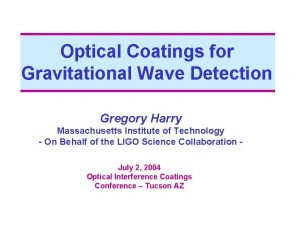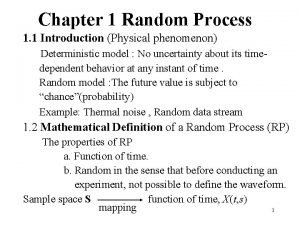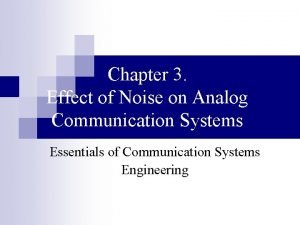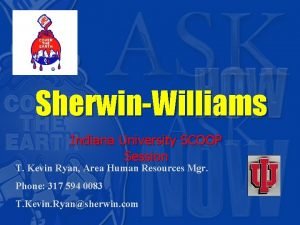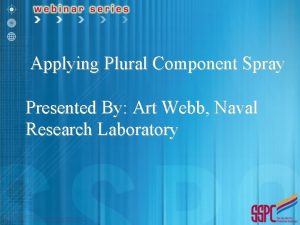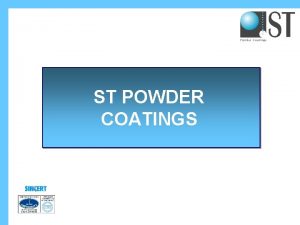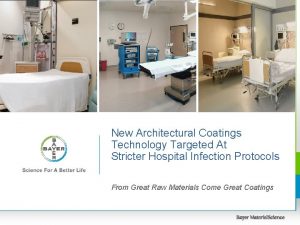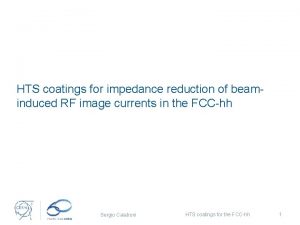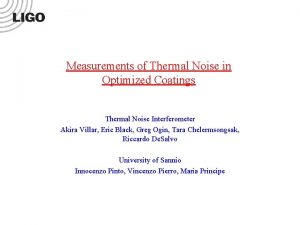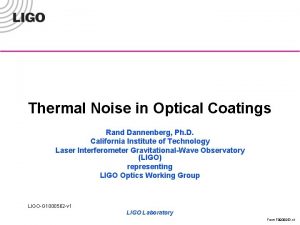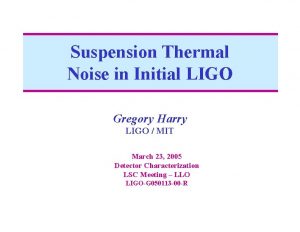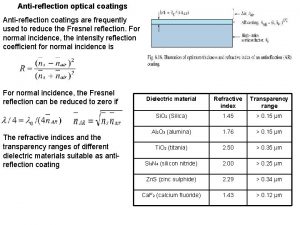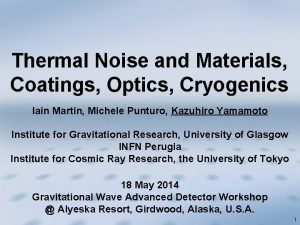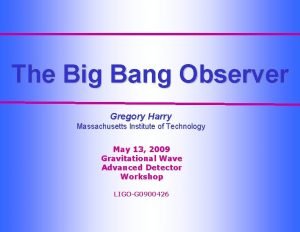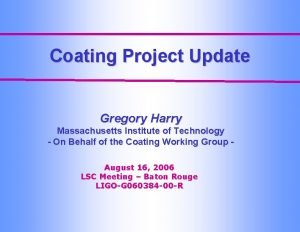Thermal noise from optical coatings Gregory Harry Massachusetts













- Slides: 13

Thermal noise from optical coatings Gregory Harry Massachusetts Institute of Technology - on behalf of the LIGO Science Collaboration 25 July 2003 10 th Marcel Grossman Meeting Rio de Janeiro, Brazil LIGO-G 030337 -00 -R

Yuri Levin's Theorem Sx(f) = 2 k. BT / (p 2 f 2) Wdiss/F 02 • Levin's theorem more easily handles loss inhomogeneities than modal expansion • Coatings contribution to thermal noise high because of proximity to laser • Other mirror losses (magnets, wire, standoffs) less important LIGO-G 030337 -00 -R

Theory of Brownian thermal noise from coatings • Derived from Levin's theorem (Gretarsson et al) • Derived independently (Nakagawa et al) • Dependance on fcoat||, fcoat+, fsub, Ycoat, and Ysub • Noise decreases as laser spot size increases Plan to use largest possible (6 cm) spots in Adv LIGO • Assumes infinite mirror substrates FEA modeling by Numata et al shows noise slightly lower for finite mirrors LIGO-G 030337 -00 -R

Advanced LIGO sensitivity Sapphire Mirrors 160 Mpc BNS Range Silica Mirrors 140 Mpc BNS Range 10 -22 h (1/Hz 1/2) 10 -22 10 -23 10 -24 10 -25 10 100 f (Hz) 1000 100 f (Hz) Coating used for Initial LIGO (REO tantala/silica) f = 1. 5 X 10 -4 Advanced LIGO target 200 Mpc BNS Range LIGO-G 030337 -00 -R

Mechanical loss in tantala/silica coatings • Measured Q's of initial LIGO coating on silica disks • Measured coatings with varying thickness and number of layers Loss depends on amount of materials Independent of number of layers • fcoat|| • fsilica • • ftantala fcoat+ = 2. 7 +/- 0. 7 10 -4 for Q measurements = 0. 5 +/- 0. 3 10 -4 = 4. 4 +/- 0. 5 10 -4 = 1. 5 +/- 0. 3 10 -4 for thermal noise • Good agreement between coatings from three vendors (REO, MLD, SMA/Virgo) • Loss too high for Advanced LIGO sensitivity Monolithic suspension and birefringence readout for thin silica sample coating measurments LIGO-G 030337 -00 -R

Advanced LIGO sensitivity vs coating loss angle Ycoat = 70 109 Pa Ycoat = 200 109 Pa Silica Q=200 106 Silica Q=130 106 Sapphire Q=200 106 Sapphire Q=60 106 LIGO-G 030337 -00 -R

Alternate materials in optical coatings I Materials other than silica and tantala have been examined • Low index material : Alumina (Al 2 O 3 with Ta 2 O 5) Mechanical loss From General Optics fal 2 o 3 consistent with 0 From MLD fal 2 o 3 = 2. 4 10 -4 Optical loss about 2 ppm after annealing (goal <1 ppm) Yal 2 o 3 > Ysio 2 • High index material: Niobia (Nb 2 O 5 with Si. O 2) Mechanical loss fnb 2 o 5 = 6. 7 10 -4 Optical loss about 0. 3 ppm after annealing (goal <1 ppm) Ynb 2 o 5 < Yta 2 o 5 LIGO-G 030337 -00 -R

Alternate materials in optical coatings II Tantala/silica with dopant added to tantala • Dopant is proprietary (SMA/Virgo) Young's modulus unchanged from Ta 2 O 5 to 0. 2 % Index of refaction unchanged from Ta 2 O 5 to 1 % Mechanical loss fta 2 o 5 = 2. 1 10 -4 (was 4. 4 10 -4) • Doped tantala/silica coating in Advanced LIGO Mechanical loss fcoat+ = 9. 0 10 -5 BNS Range 145 Mpc (was 140 Mpc) • Work is continuing on dopants in coatings Possibly related to stress reduction ? LIGO-G 030337 -00 -R

Theory of thermoelastic noise from coatings • Recent work shows that thermoelastic damping between the coating and the substrate can be a significant source of thermal noise (Fejer, Rowan et al, Braginsky et al) • Match thermal expansion between coating and substrate • Some rough loss values for coating/substrate matches Silica coating on sapphire f ~ 1 10 -3 Silica coating on silica f ~ 1 10 -5 Alumina coating on sapphire f ~ 2 10 -5 Alumina coating on silica f ~ 2 10 -4 • Baseline is sapphire substrate with alumina in coating LIGO-G 030337 -00 -R

Future plans: Improved coatings • Coating vendors are responding to request for proposals Multiple international vendors have replied Two vendors for R&D phase One (possibly two) vendors for production of optics • Three directions of research New materials - hafnia, zirconia, titania, alloys Dopants - aluminum, titanium, designed to reduce stress? Annealing - known to improve loss in silica • Input solicited from material scientists and others • Correlate loss with stress in coatings LIGO-G 030337 -00 -R

Conclusions • Internal mode thermal noise fundamental limit to gravitational wave interferometer sensitivity • Thermal noise from coatings represent significant part of overall thermal noise • Noise depends on many thermal and mechanical parameters of coatings as well as spot size • Tantala/silica coatings have been characterized, but do not meet Advanced LIGO goals • Other materials and techniques are being explored • Collaboration and plan in place to find a workable coating for advanced LIGO-G 030337 -00 -R

Future plans II: Measurements Coatings need to be characterized for all relevant parameters • Mechanical loss -ringdown Q experiments (MIT, Glasgow, Stanford, and Hobart and William Smith) • Optical loss- absorption measurements (Stanford) • Young's modulus - acoustic reflection experiment (Stanford) • Thermal expansion - optical lensing experiment (Caltech, Stanford) • Direct thermal noise measurement - (Caltech, Hongo) Interferometers to measure thermal noise in short cavities Two different spot sizes ( ~50 mm at Hongo, 160 mm at TNI) LIGO-G 030337 -00 -R

Advanced LIGO sensitivity vs coating Young's Modulus fcoat = 5 10 -5 fcoat = 1 10 -5 Silica Q=200 106 Silica Q=130 106 Sapphire Q=200 106 Sapphire Q=60 106 LIGO-G 030337 -00 -R
 Gregory harry
Gregory harry Pcm companding
Pcm companding Thermal noise is a wide sense stationary process.
Thermal noise is a wide sense stationary process. Thermal noise
Thermal noise Rumus thermal noise
Rumus thermal noise Noise in analog modulation
Noise in analog modulation Epoxy phenalkamine coatings
Epoxy phenalkamine coatings Pinnacle coatings group
Pinnacle coatings group Sherwin williams chemical coatings store
Sherwin williams chemical coatings store Plural pump system
Plural pump system Powder coating kildare
Powder coating kildare Hospital wall coatings
Hospital wall coatings Alpit metal works
Alpit metal works Hts coatings
Hts coatings
